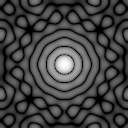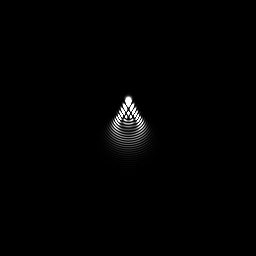

 |  |
| FFT | exact |
N = 128;
k = 8;
pupil = make_pupil(N,2*k); % construct the pupil function
rmax = N/(4*k);
w = zeros(N,N); % perfect wavefront
z = psf(pupil,w); % generate the spread function
ncen = 1+N/2;
zp = z(ncen:ncen+30,ncen); % take the central portion
xp = (0:30)/(2*k); % generate x-coordinates
% calculate exact function
xe = linspace(0,30/(2*k),500);
ze = somb(2*xe);
ze = ze.*ze;
% plot the results
plot(xe,ze,xp,zp,'o');
xlabel('radius/\epsilon_o');
ylabel('irradiance');
% generate and save the images.
% Use logrithmic transformation for output image
imshow(log_image(z,5));
imwrite(255*log_image(z,5),gray(255),'airy.bmp');
imwrite(255*pupil,gray(255),'pupil.bmp');


N = 256; k = 2; [pupil,x, rsq] = make_pupil(N,2*k); rmax = N/(4*k); w = (rsq-1.5) .* x'; z = psf(pupil,5.0*w); out = 10*z; idx = find(out>1.0); out(idx)=1.0; imshow(out); imwrite(255*out,gray(255),'coma.bmp'); imwrite(255*pupil,gray(255),'pupil2.bmp');
function [p, x, rsq] = make_pupil(N,d) % % MAKE_PUPIL [p, x, rsq] = make_pupil(N,d) % % r is the FFT cell size (in normalized pupil coordinates) % N is the number of points in the cell (should be power of 2) r = d/2; x = linspace(-r,r,N+1); x = ones(N,1)*x(1:N); xsq = x.*x; rsq = xsq+xsq'; p = rsq<=1.0;
The final image is scaled to 1
function z = psf(pupil,w) z = pupil.*exp(2*pi*j*w); z = fftshift(z); z = fft2(z); z = fftshift(z); z = z.*conj(z); zmax = max(max(z)); z = z/zmax;
function out = log_image(in, decades) % % out = log_image(in, decades) % out = 1+log10(in)/decades; out = out.*(out>0.0);
function z=somb(x) %SOMB 2*j1(pi*x)/(pi*x) function. % SOMB(X) returns a matrix whose elements are the somb of the elements % of X, i.e. % y = 2*j1(pi*x)/(pi*x) if x ~= 0 % = 1 if x == 0 % where x is an element of the input matrix and y is the resultant % output element. % Author(s): J. Loomis, 6-29-1999 z=ones(size(x)); i=find(x); z(i)=2.0*besselj(1,pi*x(i))./(pi*x(i));
Maintained by John Loomis, last updated 29 June 1999